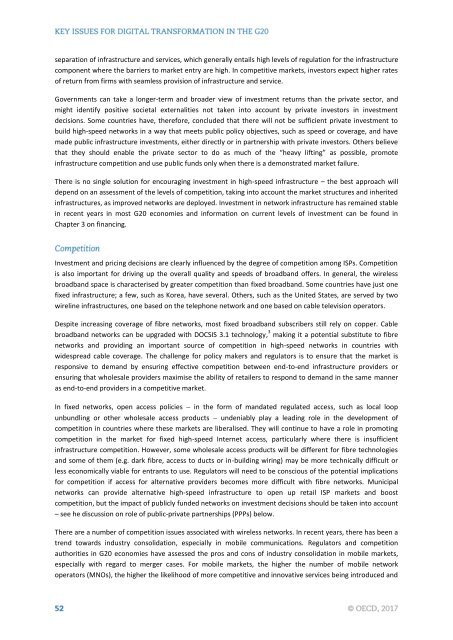KEY ISSUES FOR DIGITAL TRANSFORMATION IN THE G20
2jz0oUm
2jz0oUm
You also want an ePaper? Increase the reach of your titles
YUMPU automatically turns print PDFs into web optimized ePapers that Google loves.
separation of infrastructure and services, which generally entails high levels of regulation for the infrastructure<br />
component where the barriers to market entry are high. In competitive markets, investors expect higher rates<br />
of return from firms with seamless provision of infrastructure and service.<br />
Governments can take a longer-term and broader view of investment returns than the private sector, and<br />
might identify positive societal externalities not taken into account by private investors in investment<br />
decisions. Some countries have, therefore, concluded that there will not be sufficient private investment to<br />
build high-speed networks in a way that meets public policy objectives, such as speed or coverage, and have<br />
made public infrastructure investments, either directly or in partnership with private investors. Others believe<br />
that they should enable the private sector to do as much of the “heavy lifting” as possible, promote<br />
infrastructure competition and use public funds only when there is a demonstrated market failure.<br />
There is no single solution for encouraging investment in high-speed infrastructure – the best approach will<br />
depend on an assessment of the levels of competition, taking into account the market structures and inherited<br />
infrastructures, as improved networks are deployed. Investment in network infrastructure has remained stable<br />
in recent years in most <strong>G20</strong> economies and information on current levels of investment can be found in<br />
Chapter 3 on financing.<br />
Investment and pricing decisions are clearly influenced by the degree of competition among ISPs. Competition<br />
is also important for driving up the overall quality and speeds of broadband offers. In general, the wireless<br />
broadband space is characterised by greater competition than fixed broadband. Some countries have just one<br />
fixed infrastructure; a few, such as Korea, have several. Others, such as the United States, are served by two<br />
wireline infrastructures, one based on the telephone network and one based on cable television operators.<br />
Despite increasing coverage of fibre networks, most fixed broadband subscribers still rely on copper. Cable<br />
broadband networks can be upgraded with DOCSIS 3.1 technology, 3 making it a potential substitute to fibre<br />
networks and providing an important source of competition in high-speed networks in countries with<br />
widespread cable coverage. The challenge for policy makers and regulators is to ensure that the market is<br />
responsive to demand by ensuring effective competition between end-to-end infrastructure providers or<br />
ensuring that wholesale providers maximise the ability of retailers to respond to demand in the same manner<br />
as end-to-end providers in a competitive market.<br />
In fixed networks, open access policies in the form of mandated regulated access, such as local loop<br />
unbundling or other wholesale access products undeniably play a leading role in the development of<br />
competition in countries where these markets are liberalised. They will continue to have a role in promoting<br />
competition in the market for fixed high-speed Internet access, particularly where there is insufficient<br />
infrastructure competition. However, some wholesale access products will be different for fibre technologies<br />
and some of them (e.g. dark fibre, access to ducts or in-building wiring) may be more technically difficult or<br />
less economically viable for entrants to use. Regulators will need to be conscious of the potential implications<br />
for competition if access for alternative providers becomes more difficult with fibre networks. Municipal<br />
networks can provide alternative high-speed infrastructure to open up retail ISP markets and boost<br />
competition, but the impact of publicly funded networks on investment decisions should be taken into account<br />
– see he discussion on role of public-private partnerships (PPPs) below.<br />
There are a number of competition issues associated with wireless networks. In recent years, there has been a<br />
trend towards industry consolidation, especially in mobile communications. Regulators and competition<br />
authorities in <strong>G20</strong> economies have assessed the pros and cons of industry consolidation in mobile markets,<br />
especially with regard to merger cases. For mobile markets, the higher the number of mobile network<br />
operators (MNOs), the higher the likelihood of more competitive and innovative services being introduced and


